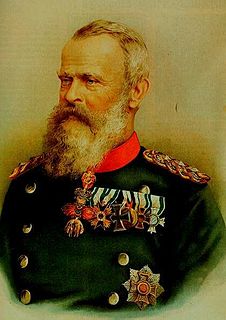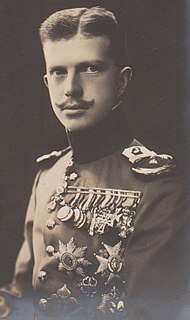




- Luitpold, Prince Regent (1821–1912)

- (1) Crown Prince Rupprecht (b.1869)
- (2) Prince Albrecht (b.1905)
- (3) Prince Karl (b.1874)
- (4) Prince Franz (b.1875)
- (5) Prince Ludwig (b.1913)
- (1) Crown Prince Rupprecht (b.1869)
- (6) Prince Leopold (b.1846)
- (7) Prince Georg (b.1880)
- (8) Prince Konrad (b.1883)
- Prince Adalbert (1828–1875)
- (9) Prince Ludwig Ferdinand (b.1859)
- Infante Ferdinand of Spain, former Prince Ferdinand (b.1884) (renounced rights)
- Infante Luis Alfonso of Spain (b.1906)
- Infante José Eugenio of Spain (b.1909)
- (10) Prince Adalbert (b.1886)
- Infante Ferdinand of Spain, former Prince Ferdinand (b.1884) (renounced rights)
- (11) Prince Alfons (b.1862)
- (12) Prince Joseph Clemens (b.1902)
- (9) Prince Ludwig Ferdinand (b.1859)
Current Line of Succession
This section does not cite any sources .(August 2020) (Learn how and when to remove this template message) |

- Luitpold, Prince Regent of Bavaria (1821-1912)

- Rupprecht, Crown Prince of Bavaria (1869-1955)
- Albrecht, Duke of Bavaria (1905-1996)
- Franz, The Duke of Bavaria (born 1933)
- (1) Prince Max of Bavaria, Duke in Bavaria (born 1937)
- Albrecht, Duke of Bavaria (1905-1996)
- Prince Franz of Bavaria (1875-1957)
- Prince Ludwig of Bavaria (1913-2008)
- (2) Prince Luitpold of Bavaria (born 1951)
- (3) Prince Ludwig of Bavaria (born 1982)
- (4) Prince Heinrich of Bavaria (born 1986)
- (5) Prince Karl of Bavaria (born 1987)
- (2) Prince Luitpold of Bavaria (born 1951)
- Prince Rasso of Bavaria (1926-2011)
- (6) Pater Florian von Bayern, O.S.B. (born 1957)
- (7) Prince Wolfgang of Bavaria (born 1960)
- (8) Prince Tassilo of Bavaria (born 1992)
- (9) Prince Richard of Bavaria (born 1993)
- (10) Prince Philipp of Bavaria (born 1996)
- (11) Prince Christoph of Bavaria (born 1962)
- (12) Prince Corbinian of Bavaria (born 1996)
- (13) Prince Stanislaus of Bavaria (born 1997)
- (14) Prince Marcello of Bavaria (born 1998)
- Prince Ludwig of Bavaria (1913-2008)
- Rupprecht, Crown Prince of Bavaria (1869-1955)
- Prince Adalbert of Bavaria (1828-1875)
- Prince Ludwig Ferdinand of Bavaria (1859-1949)
- Prince Adalbert of Bavaria (1886-1970)
- Prince Konstantin of Bavaria (1920-1969)
- (15) Prince Leopold of Bavaria (born 1943) - current heir to Otto I, King of Greece (Leopold's eldest son Prince Manuel of Bavaria was born out of wedlock and is not in the line of succession)
- (16) Prince Konstantin of Bavaria (born 1986)
- (17) Prince Adalbert of Bavaria (born 1944)
- (18) Prince Hubertus of Bavaria (born 1989)
- (15) Prince Leopold of Bavaria (born 1943) - current heir to Otto I, King of Greece (Leopold's eldest son Prince Manuel of Bavaria was born out of wedlock and is not in the line of succession)
- Prince Konstantin of Bavaria (1920-1969)
- Prince Adalbert of Bavaria (1886-1970)
- Prince Ludwig Ferdinand of Bavaria (1859-1949)
- Luitpold, Prince Regent of Bavaria (1821-1912)
In fiction
- H.G. Wells, describing in "The Shape of Things to Come" the rise of a world government and its unification of the world, depicts a "Prince Manfred of Bavaria" as the leader of a widespread rebellion against that nascent government, occurring at the end of the 20th Century (see ).
Notes
- ↑ Constitution of the Kingdom of Bavaria, 1818 Archived 2009-12-12 at the Wayback Machine
- ↑ Hermann Schulze: die Hausgesetze der regierenden deutschen Fürstenhäuser. 1. Bd. Jena, 1862. pp. 337-47. Cited in Bavarian Royal Family Statute, 1819
- ↑ Dieter J. Weiss, Kronprinz Rupprecht von Bayern (1869-1955): Eine politische Biografie (Regensburg: Friedrich Pustet, 2007): 346.
- ↑ Genealogie des Hauses Wittelsbach. München: Verwaltung des Herzogs von Bayern, 2000.
Further reading
- Francois Velde, Succession Laws of the Wittelsbach (Palatinate, Bavaria).
















